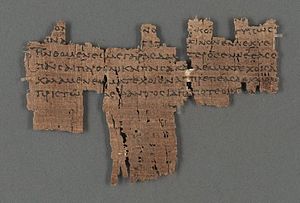Alcman facts for kids
Alcman (pronounced Alk-man) was an ancient Greek poet from Sparta. He lived around the 7th century BC. Alcman is known as one of the earliest and most important of the "Nine Lyric Poets" from ancient times. He wrote many choral poems, which were songs performed by groups of people. Most of his poetry is now lost, but we know about it from small parts quoted by other ancient writers and from pieces of papyrus found in Egypt.
Contents
About Alcman
We don't know the exact dates for Alcman, but he was probably active in the late 600s BC. His parents' names are not fully known. Even in ancient times, people argued about where Alcman was born. Some thought he was from Sardis, a city in ancient Lydia (part of modern-day Turkey). Others believed he was from Laconia, the region where Sparta is located.
Alcman's poetry often mentioned Lydian and Asian culture. For example, he once said he learned his skills from "strident partridges," a bird found in Asia Minor, not usually in Greece. This made some people think he was from Lydia. However, Sardis was a very diverse city back then. So, these references might have just been a way to describe the girls in his choruses as being fashionable.
One old story, told by the famous thinker Aristotle, says that Alcman came to Sparta as a slave. He was owned by a family named Agesidas. But because of his amazing talent, he was later set free. According to another ancient writer named Pausanias, Alcman is buried in Sparta, near a special place for Helen of Troy.
Alcman's Poetry
In ancient times, there were six books of Alcman's choral poems. These were long hymns, perhaps 50 to 60 of them. Sadly, they were lost around the Middle Ages. For a long time, people only knew Alcman from small quotes in other Greek writings.
Then, in 1855, something exciting happened! A piece of papyrus was found in a tomb near a pyramid in Saqqara, Egypt. This papyrus contained about 100 lines of a poem called a partheneion. A partheneion was a song performed by a chorus of young, unmarried women. This important fragment is now kept in the Louvre museum in Paris.
In the 1960s, even more fragments of Alcman's poems were found. These were discovered in Egypt at an ancient garbage dump in a place called Oxyrhynchus. Most of these new pieces were also partheneia, but there were other kinds of hymns too.
His Language
Alcman's songs were written in the Doric dialect, which was the language spoken in Sparta. Even though this dialect wasn't always considered beautiful, the ancient writer Pausanias said it didn't spoil the beauty of Alcman's songs at all.
Alcman's language also had influences from the Homeric Greek language, which was used in famous epic poems like the Iliad and the Odyssey. This mix of different language styles makes his poetry unique and interesting to study.
How His Poems Were Structured
From the larger pieces of his poems that we have, we can tell that Alcman's poetry usually followed a pattern. Different rhythms and meters were combined into long sections called stanzas. These stanzas could be 9 to 14 lines long and were repeated several times in a song.
One common rhythm he used was the dactylic tetrameter. This is different from the dactylic hexameter, which was used by famous poets like Homer.
What Alcman Wrote About
Alcman most often wrote hymns, which are songs praising gods. He also wrote partheneia (maiden-songs) and prooimia (preludes, or introductions, to epic poems). Many of the pieces we have are very small, so it's hard to know exactly what they were about.
The most important fragment is the First Partheneion, also called the Louvre-Partheneion. It was found in Egypt in 1855. This poem has 101 lines, but more than 30 of them are badly damaged. Scholars still debate what this poem means and when it might have been performed.
Alcman's choral songs were meant to be performed as part of Sparta's social, political, and religious life. Most of the surviving fragments are from songs sung by choruses of young women. Some scholars think these performances were like a type of drama.
Praising Nature and Life
No matter the topic, Alcman's poetry has a clear, light, and pleasant feel. Ancient writers often commented on this. He carefully described details from rituals and festivals, even if we don't fully understand their meaning today.
Alcman's language is full of vivid descriptions. He paid a lot of attention to nature: deep valleys, tall mountains, forests blooming at night, and the soft sound of water moving over seaweed. His poems are also filled with animals and creatures: birds, horses, bees, lions, reptiles, and even tiny insects.
Here's a famous example of his beautiful descriptions:
Asleep lie mountain-top and mountain-gully, shoulder also and ravine; the creeping-things that come from the dark earth, the beasts whose lying is upon the hillside, the generation of the bees, the monsters in the depths of the purple brine, all lie asleep, and with them the tribes of the winging birds.
See Also
 In Spanish: Alcmán para niños
In Spanish: Alcmán para niños
- Papyrus Oxyrhynchus 8



